Marta, Liviu (szerk.): Satu Mare. Studii şi comunicări. Seria arheologie 26/1. (2010)
János Németi: Acâs - Râtul lui Veres (Veres-rét). The Late Bronze Age settlement
Acâ.s - Râtul lui Veres (Veres-rét). The Late Bronze Age settlement superimposed by a daub deposition and many pottery shards of the Celtic La Téne type. This pit registered several successive depositions comprising of vessel shards which have largely been restored. The first deposition appeared at 0,14-0,15 m below level LT. and comprised of large shards from a large-sized vessel and a cup. The second level showed up at 0,35 m deep and was 0,40 m thick. It comprised of several fragmentary vessels and large pieces of the storage vessels mentioned above. The third deposition appeared at 0,70 m in depth and comprised of several mug type vessels, cups, “fish tray”-like vessel, several types of tureens covered by large fragments from the storage vessels. At a depth of 0,90 m the coating plant and the deposition from the Baden/Coţofeni were cut into, at 1,10 m the base of the pit appeared perfectly flat, clayed, with a thick layer of ash and charcoal. Besides these, there were also daub fragments and a large shard of a portable-cooking vessel. The way the depositions were arranged in pit 2 attest a magic-ritual deposition, a deposition of the type ‘bodgros’ (cassette C had 2,4x1,2 m in Sizes, crossing also SV). SIV. It has been investigated beyond the levee, on the right side, on the way to the commune. It was 10x2 m in size, 0,80 m in depth, roughly oriented east-west, on the old river course of Crasna river. Observations in stratigraphy: at 0-0,15/0,20 m in depth is the present coating plant; at 0,20-0,35 m in depth was a black coloured deposition with many pottery shards and animal bones; at a depth between 0,30-0,50 m occurred a grey-coloured deposition containing fluffy soil, pottery fragments specific of the Ottomany culture, phase III; at 0,25- 0,70 m deep was the antique coating plant with inclusions of fired clay and pottery fragments of the Coţofeni/Baden type. At about 0,80-0,85 appeared the sandy yellow loam. The trench profile revealed a small pot with scanty Hajdiibagos/Pişcolt-Cehăluţi materials (Gr. 16c), which has not been dug out because the existence of an earth road. Pit no. 16 has been observed in the trench profile, and has been by cassette D of 3x1,2 m in size. The completely opened pit contained much ash, animal bones, and pottery shards made with the slow wheel, typical of the 11th-12th centuries - the Age of Arpad. The pit was dug up from another pit that contained pottery shards of the Bronze Age (Gr. 16a). There was another pit in the trench profile (Gr. 16b) which contained typical pottery shards of the Late phase of the Ottomany culture. SV. The trench was drawn in an area nearby the dam. It had a recent deposition of 0,30-0,40 m thick. This way could be observed the first layer of coating plant, below which was a layer of charred remains of 5-10 cm and much ash, fragments of fired clay and pottery shards of the Age of Arpad. This level might be related to a strong fire, maybe the invasion of the Tartars which left the village destroyed. At the same level showed up a bread oven with heavily fired base that superimposed a layer of pottery shards meant to isolate, typical of the 11th -13th centuries. By the oven was discovered a small pit, uncovered through cassette N in which was found a dog skeleton. The SV.D profile revealed a semi-subterranean dwelling in cassette E, which dated back to the 6th-7th centuries (L2-Slav), fit with an oven that held ‘Tonbrote breads’ in it. In the dwelling was outlined pit no. 15 with much ash and many pottery shards of the 11th-13th centuries. This pit was closely related to the bread oven mentioned above. SVII. It had 10x2 m in size, 0,65-0,70 cm the maximum diameter, located nearby SIV, on the bank of a completely disturbed area. The Late Bronze Age cultural layer occurred below the present humus, at 10-15 cm deep. It was a black-coloured deposition, roughly 15-20 in thickness and contained pottery shards of the Hajdiibagos/Pişcolt-Cehăluţi type. Below this cultural layer appeared a grey deposition of 25-40 cm in thickness that contained pottery fragments dating from the Middle Bronze Age, the Late Ottomany culture. At the level of the antique coating plant layer was noticed a small feature that contained daub or rather fired clay (hearth?) with few pottery shards of the Coţofeni type. In SVII, nearby the collapsed riverside, appeared a pit with pottery shards, large pieces of stone, the traces of an oven which was uncovered in cassette M (2x1 m) that contained pottery shards of the 7th -8lh centuries (?). In 269
